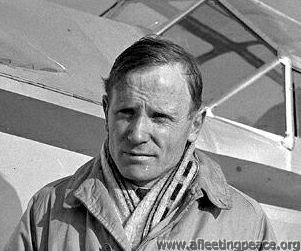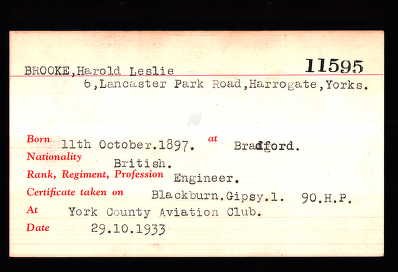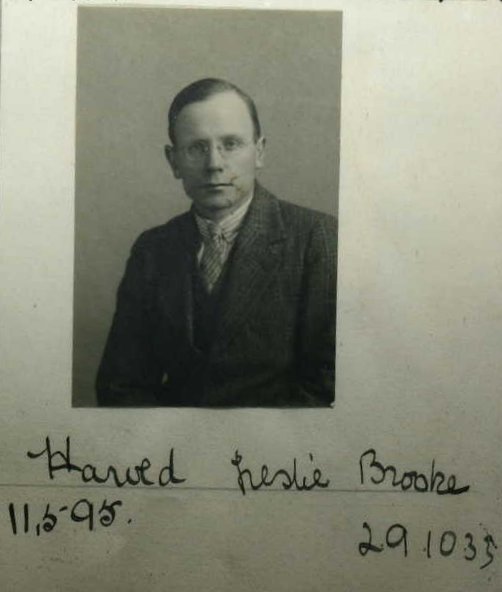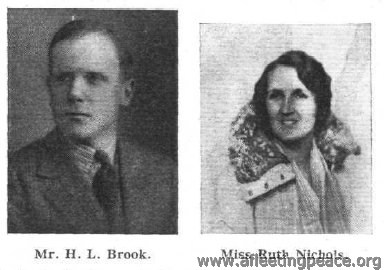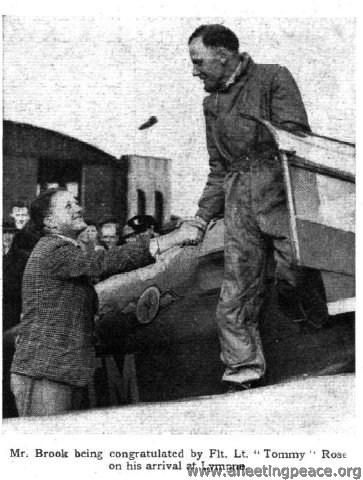|
Harold Leslie Brook
|
||
|
b. 11 October 1897, in Bradford Only learnt to fly in 1933, and just scraped up the minimum 100hrs solo flying time required to enter the Race. The aircraft was barely ready in time either; a month before the start it didn't have any seats, and was in "a very unfinished condition". Harold was not impressed by "those fools at Reading [i.e. Miles Aircraft]... this is not the first time they have omitted to do something". In March 1934, he tried to break the England-Australia solo record (held by CWA Scott) but only got as far as the Cevennes before crashing into one of the large mountains they have there. To give him his due, he picked up the important bits of his aeroplane, brought them back and used the engine in this Miles Falcon. In 1935, after taking part in the MacRobertson, he flew back from Australia in record time; you might like to see him talk about his record-breaking flight (on the other hand, you may have some drying paint that needs watching); if so, click Record Flight From Australia - British Pathé (britishpathe.com) Two years later, he added the Cape Town record. Mercifully, there don't appear to be any interviews about this one. Pilot Officer in the Administrative and Special Duties Branch in May 1940, then briefly (28 Oct 1940 - 3 May 1941) in the Air Transport Auxiliary (ATA) And, despite what you may read or hear, was never an accountant in his life (although with his spectacles on, he did rather look like one, and when he talked, he did rather sound like one [sorry]), and he signed himself 'Brook', not 'Brooke'. But 'e were definitely from 'Arrogate.
H. L. BROOK writes to TERRY'S Dear Sirs, I should like to take this opportunity of congratulating you on the excellence of your Springs in my Gipsy 6 Engine. In a record-breaking flight of this description the engine has to be run for long periods in extreme temperatures, and at a higher rate of revolutions than normal, and for a valve spring to break would spell disaster. I had never at any time any fear of this happening with your springs, and they are now at the end of the flight in just as good condition as they were at the start. Yours faithfully, (signed) H. L BROOK. 'Flight' Racing No. 31—H. L. Brook, and —? And speaking of Bradford, here is Harold Leslie Brook, who was born there in 1897, and now resides in Harrogate. He joined the Royal Field Artillery on August 20, 1914, at the age of 16, obtained his commission soon afterwards, and, despite a couple of wounds, served five years in France and India.
Restored to his family, he remained a normal civilian until Yorkshire began to build and fly sailplanes and gliders. These occupations kept him mildly diverted until the approach of his 37th birthday. Then he began to yearn for horse-power. The York County Aviation Club at Sherburn-in-Elmet offered a likely fulfilment of this secret ambition. So, in August, 1933, Brook placed himself in the hands of Instructor Cudemore, and after four hours' instruction became a soloist with serious designs on the MacRobertson Handicap, for which Phillips and Powis have built him the first of their Miles 'Falcons'. What happened between last autumn and this spring is now almost historic. Brook bought the "Puss Moth" (Heart's Content) in which the Mollisons had crossed the Atlantic, and, with a total of 43 hr. in his logbook, pushed off solo from Lympne to survey the route to Melbourne. That was on March 28, 1934, at 5.20 a.m. By noon the incident had closed. Describing it a few days later Brook said that, while flying through very dirty weather over France, he was forced down from 12,000 ft. by ice formation on the wings, and, before he knew how or why, the side of an unsuspected mountain was rushing up at him out of the murk. Guided by some uncanny sixth sense, he brought off a bloodless landing on the mountain proper. The scene of this epic of the air was Genolhac, in the Cevennes. With some local help he salvaged the "Gipsy Major," brought it back to England, and has had it installed in Heart's Content II. Brook's next attempt on the Australian record will not be solo. If expectations are realised, he will be accompanied by two lady passengers. 'Flight' Another England-Australia attempt MR. H. L. BROOKE, a member of the York County Aviation Club, left Lympne at dawn on the morning of Wednesday, March 28, on an attempt to break the record for the England-Australia trip held by Sir Charles Kingsford-Smith with the time of 7 days 3 hours. Mr.Brooke was flying the " Puss Moth " (" Gipsy III ") Heart's Content, in which Mr. J. A. Mollison made an Atlantic crossing. A few hours after leaving Lympne, while flying through fog, he crashed in deep snow near Genholac, in the Cevennes. The machine was completely wrecked, but Mr. Brooke escaped with nothing worse than some bad bruises. For five hours he wandered about inthe mountains, and eventually found a small village, where he was given every attention. Later he returned to the wreck of his machine, and removed the instruments and other articles of value. 'Flight' April 4, 1935 YORK COUNTY AVIATION CLUB, SHADWELL, LEEDS During March the York County Aviation Club, Ltd., flew 63 hours at Sherburn-in-Elmet, and Miss Maurice and Mr.Pilkington made first solos. Two machines flew to Nottingham for the club dance, and Mr. Humble, the honorary instructor, has presented the club with a fire tender—a very apposite gift! The next dance will be held on April 13. Mr. H. L Brook, who has just broken the Australia-England record with a Miles " Falcon," was trained at Sherburn—which appears to be a pretty good advertisement for the instruction. 'Flight' These days, the home of Sherburn Aero Club: http://www.sherburn-aero-club.org.uk/ SWIFTLY from AUSTRALIA How H. L. Brook, in a " Gipsy "-engined Miles "Falcon" broke the Solo Record : His Story in an Interview with " Flight "LAST Sunday afternoon, at 3.55 p.m., the original Miles" Falcon " landed at Lympne, having flown in 7 days•* 19 hr. 50 min. from Darwin, North Australia, withMr. H. L. Brook, of Harrogate, at the controls. The •pilot thus beat the unofficial " s o l o " record of Mr. C. J.Melrose by 13 hr. 10 min., and the officially recognisedperformance of Mr. J. A. Mollison by 1 day 2 hr. 25 min.The shortest time for the Australia-England trip is still,of course, the 6 days 16 hr. 10 min. of Cathcart Jones andWaller in a " C o m e t ."After leaving Darwin at 5.30 a.m. on Sunday, March 24(Australian time), Mr. Brook's time-table was as follows:—Sunday night, arrived Rambang ; Monday, Penang; Tuesday,Rangoon; Wednesday, Calcutta; Thursday, Karachi; Friday,Athens; Saturday, Rome; Sunday, Marseilles (9.25 a.m.) ;Lympne (3.55 p.m.).the Timor crossing, he told a member of the staff of Flight,was " r o t t e n , " with rain, low clouds and heavy head winds.On the trip from Penang he landed on the delta near Calcutta.Over the Sundarbans low clouds and darkness caused him totake this measure rather than to fly on, possibly missingCalcutta, and, as he put it, perhaps making a crash landingthrough shortage of petrol.Perhaps the worst section of the trip was that betweenAthens and Rome, particularly the portion over the channelof Corfu, where a gale was encountered. At Brindisi Mr.Brook was advised not to proceed, but he pushed on andcrossed the Apennines in a snowstorm.And what of the man himself? He is a thirty-eight-yearoldYorkshireman, who, despite the newspaper stories, hasnever been an accountant in his life. When he was youngerhe indulged in motor racing and later built a few sailplanesand gliders. Then he joined the York County Aviation Cluband went solo after four hours' instruction. He next boughtMr. J. A. Mollison's "Puss Moth" Heart's Content, and setout for Australia to survey the route to Melbourne, for he haddecided to enter the MacRobertson Handicap. But ice formationforced the " Puss Moth " down on a mountain side inthe Cevennes. Neither Brook nor the "Major" (which, itshould be remembered, had already been flown over the SouthAtlantic) was rendered hors de combat, however. The enginewas salvaged and Brook brought it back to England, where itwas installed in the first of the Miles " Falcons" which thenwas fitted with extra tanks for the race. During the event itcarried a lady passenger and a large helping of appalling
luck (no connection is suggested between the two facts!).Suffice it to say that the Australian trip, a large portion ofwhich was made in easy stages, took about twenty-six daysDuring his stay "down under," Brook worked until the" F a l c o n " and its engine were in tip-top condition beforestarting his almost unheralded flight.Of travelling in the "Falcon " he says that, compared withflying in an ordinary aeroplane with open cockpits, it was" like travelling in a saloon car instead of on a motor cycle. The veteran "Gipsy Major" was run throughout the flight at 2,100 r.p.m. HILLSON PRAGA Imported specimen 107 Praga E.114 OK-PGC. Regd G-ADXL (CofR 6479) 27.11.35 to F Hills & Son Ltd; dd Speke to Barton 30.12.35. CofV 91 issued wef 27.2.36. Dd 20.4.36 to Harold Leslie Brook; flown by him to South Africa, departing England 6.5.36; arriving Cape Town 22.5.36. Regn cld 6.36 as sold. Regd ZS-AHL 6.36 to OG Davies, Cape Town. Sold 8.37 to H Cooper, Cape Town. Converted to glider at Youngsfield 9.53.
30th Aug. 1940. ADMINISTRATIVE AND SPECIAL DUTIES BRANCH. Harold Leslie BROOKE, D.C.M. (84353). |
- Details
- Hits: 3504

